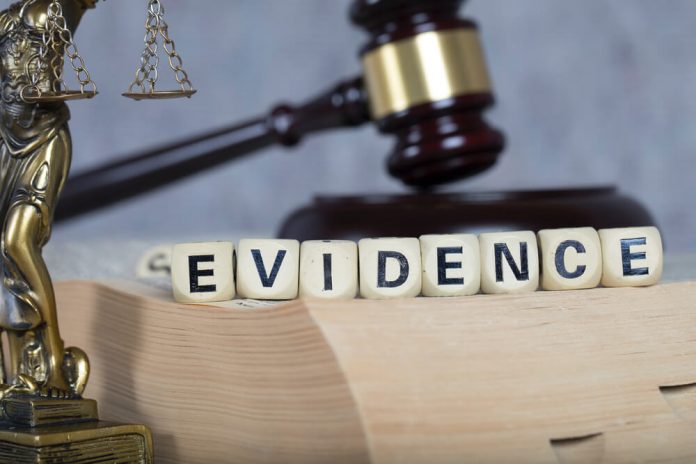This article was submitted by Ms. Rayman Kaur, a legal counsel working with a prestigious pharmaceutical company. This article explains the concept of evidence and its various kinds, as prescribed under the Evidence Act, 1872. It emphasises on Documentary Evidence- primary and secondary evidence by way of various examples, the difference between the two, and various judicial pronouncements.
It has been published by Rachit Garg.
Table of Contents
Introduction
The term ‘Evidence’ has been derived from the Latin word ‘evidere’, which means to show clearly or to make certain, plain, ascertain or prove. In layman’s terms, the word ‘evidence’ can be defined as a set of facts or information substantiating the argument or proposition put forth by the parties.
Evidence plays a crucial role in every legal system. Each case that comes before the court of law has to be supported by evidence, as it helps the court establish the genuineness of the arguments made by the parties. From the stage of admission of a case in court until the pronouncement of judgement, evidence plays a vital role.
Types of evidence
Evidence can be broadly classified evidence into two categories:
- Oral evidence; and
- Documentary evidence.
As per the language of Section 3 of the Indian Evidence Act, 1872, “Evidence” means and includes–
- All statements which the court permits or requires to be made before it by witnesses in relation to matters of fact under inquiry, such statements are called Oral Evidence; and
- All documents including electronic records produced for the inspection of the Court, such documents are called Documentary Evidence.
In other words, oral evidence, as its name suggests, may be referred to as the words of a person who is credible enough to give statements in a court of law, and his statements are not required to be corroborated with documentary evidence. Whereas, Documentary Evidence includes all kinds of documents which are produced before the court to prove certain facts of the matter and are physical/tangible in nature. Secondary evidence is further divided into two categories, namely, primary evidence and secondary evidence.
What is primary evidence
Primary evidence is considered the best quality of evidence and is referred to as the documents produced before the court of law for inspection. Section 62 of the Indian Evidence Act, 1872, explains primary evidence by stating that when a document is in various parts, each part of the document forms a part of the primary evidence. But if the documents are merely copies of a common original work, then they cannot be considered as primary evidence of the original work. For instance, a movie script is written, and copies of it are handed over to all the members of the cast, but the copies of the original movie script are not the primary evidence; only the one whose copies were made is the primary evidence.
Illustrations
- Original Art which includes painting, drawing, plans, sculptural drawings, blueprints, etc.
- Manuscripts, scriptures, books which are original and not copies of original. It can also include handwritten notes or plans, memoirs, diary entries, letters, etc.
What is secondary evidence
Secondary evidence, as the name suggests, is the evidence that is used in the absence of any primary evidence and is defined under Section 63 of the Indian Evidence Act, 1872.
A bare reading of Section 63 of the IEA, 1872, secondary evidence means and includes:
- Certified copies under the provisions of Section 76 of the Indian Evidence Act, 1872;
- Copies of the original while ensuring accuracy in such copying, which is to say that a copy which has been transcribed from the original is considered as secondary evidence and is admissible in the court of law;
- Copies produced from or compared with the original, which means that the copy so produced must be compared with the original to be called as secondary evidence if not compared then it fails to be a secondary evidence;
- Counterparts of documents as against the party/parties who had not executed them;
- Oral accounts of the contents of a document given by the person who has himself seen the document must be closely examined before relying on it.
Illustrations
- A photograph of the original is admissible as secondary evidence of its contents, even when the two have not been compared.
- If a copy of a letter is made using the copying machine and it has been proved that such copy was made from the original document, then it is admissible as secondary evidence in the court of law.
- If a copy is transcribed from another copy, but is afterwards compared with the original, then it would be considered as secondary evidence; but if one fails to compare the copy with the original then it cannot be referred to as secondary evidence of the original. It is irrelevant even if the copy from which the second copy was made has been compared with the original.
- Neither any oral account of a copy compared with the original, nor any oral account of a photograph or machine-copy of the original, can be considered as secondary evidence of the original.
Provisions in the Indian Evidence Act
Circumstances where Secondary Evidence relating to documents, is admissible
Section 65 of the Act enumerates the situations/circumstances wherein secondary evidence is admissible in place of primary evidence. These are as follows:
- In case where the originals are in possession of :
- a person against whom the said document is sought to proved; or
- a person who is not reachable; or
- a person who is legally obligated to produce such document but fails to produce the same even though a notice under Section 66 of Evidence Act has been served upon him;
- In case where the person against whom the said document was to be proved, admits in writing the existence, condition or contents of the original;
- In the case where the original document has either been destroyed or lost, or when the party that offers to produce evidence fails to do so within a reasonable time, due to reasons others than their own neglect or default;
- In cases where the original/primary evidence is immovable, for instance, it is a caricature or inscription (as defined under Section 3 of Indian Evidence Act) then in such circumstances secondary evidence can be admitted;
- In case where the original document is a public document and falls within the definition of Section 74, then certified copy of such documents can be tendered;
- In cases where the original document is of such nature that the Evidence Act itself permits certified copy of the same;
- In cases where numerous documents are to be produced which are not convenient for the Court to examine; or the fact to be proved is the general result of the entire set of documents.
In situations (1), (3), and (4), any secondary evidence proving the contents of the document is admissible. Furthermore, in case (2), only written admission can be tendered. In cases (5) and (6), only certified copies of the original document are admissible as secondary evidence. Lastly, in case (7), evidence can be given by any person who has examined all the documents, who is an expert in examining such documents.
Circumstances when secondary evidence can be tendered without rendering any notice for its production
Section 66 of the Act prescribes conditions wherein secondary evidence can be rendered to the court of law without serving any notice:
- when the document which is to be proved is itself a notice;
- when, from the subject matter of the case, the opposing party must realise that he will be expected to produce it;
- when it appears or is demonstrated that the opposing party has acquired possession of the original document by fraud or force;
- when the opposing party or his agent has the original document in the Court;
- when the opposing party or his agent has admitted the loss of the document;
- when the individual possessing the document is not reachable, or not subject to, the course of the Court.
Difference between primary and secondary evidence
| S.NO. | PRIMARY EVIDENCE | SECONDARY EVIDENCE |
| 1. | Section 62 of the Evidence Act defines primary evidence. | Section 63 of the Evidence Act defines secondary evidence. |
| 2. | It is considered the best or finest quality of evidence in a court of law. | It is used in the absence of primary evidence and is considered as lower quality of evidence. |
| 3. | The original document or work that can be produced before the court of law for inspection can be considered primary evidence. | Any and/or all kinds of copies made of the original document/work as mentioned under Section 63, form part of the secondary evidence. |
| 4. | Primary evidence can be presented to the court without serving any prior notice. | Permission is to be sought from the court to lead secondary evidence on the grounds of the unavailability or loss of original documents. |
| 5. | It has high evidentiary value in the court as it is the main source of evidence. | It has low evidentiary value in court as it is an alternative source of evidence. |
| 6. | Birth Certificate issued by the MCD is primary evidence. | In case of loss of birth certificate, Copy of the 10th marksheet if it has Date of Birth is admissible or any ID Proof i.e. Voter Card or Aadhar Card are also admissible and are secondary evidence of the birth certificate. |
Judicial pronouncements
The various judicial pronouncements over the years have given clarity on the subject of importance of primary evidence as well as the admission of secondary evidence in the absence of primary evidence.
- The Hon’ble Supreme Court in J. Yashoda v. Smt. K. Shobha Rani, 2007(2) R.C.R.(Civil) 840 : 2007(1) R.C.R.(Rent) 466 : 2007(2) held that “it is a general rule that the Secondary evidence can be admitted only in the absence of primary evidence. In a situation where the original is found to be inadmissible as the party who files it to prove its validity has failed to do so, then the said party cannot be allowed to introduce any secondary evidence of its contents”
- In the case of H. Siddiqui (dead) by LRs Vs. A. Ramalingam 2011 (4) SCC 240, the Apex Court reiterated that “where the originals are not produced then secondary evidence without providing a rational reason and factual foundation for laying such evidence is established, the court cannot permit the party to adduce secondary evidence”.
- In Rakesh Mohindra v. Anita Beri and Ors. (2016) 16 SCC 483, the Hon’ble Supreme Court held that:
“15. The preliminary requisite for leading secondary evidence is that the party relying upon the original documents were unable to produce them in spite of their best efforts, due to reasons beyond its control. Furthermore, in order to produce secondary evidence before the court of law, the party must establish the plausible reason for the non-production of primary evidence. Secondary evidence cannot be accepted until it is established that the said original documents are lost or are/have been destroyed or have been deliberately withheld by the party against whom the said documents were sought to be used”.
- The Hon’ble Apex Court in Chandra v. M. Thangamuthu (2010) 9 SCC 712 held that “the secondary evidence must be authenticated by foundational evidence that the alleged copy is in fact a true copy of the original. It should be emphasised that the exceptions to the rule requiring primary evidence are designed to provide relief in a case where a party is genuinely unable to produce the original through no fault of that party.”
Conclusion
Primary evidence is a high form of evidence in law, whereas secondary evidence is considered to be a substitute for primary evidence. But each of these falls under the definition of ‘evidence’ under Section 3 of the Indian Evidence Act. It is a trite law that secondary evidence can only be admitted in exceptional circumstances. It has also been established by way of various judgements that the presentation of primary evidence is the general rule and the presentation of secondary evidence in a court of law is an exception to that general rule.
However, there are numerous circumstances when primary evidence is unavailable or impossible to present in court due to the reasons mentioned in Section 65 of the Act. In such circumstances, the court admits the secondary evidence in order to meet the ends of justice. Documentary evidence is covered under Chapter V of the Indian Evidence Act, 1872, wherein both primary and secondary evidence are defined and what each includes, including exceptional circumstances when secondary evidence can be presented in place of primary evidence, etc., have been explained in an elaborate manner .
Frequently Asked Questions
What are the various types of secondary evidence?
Secondary evidence includes certified copies, age certificate, photograph, copies made by using mechanical process, tape recordings, oral accounts, photocopies, newspaper report, unprobated will, voter’s list, duplicates/Xerox, typed copy, carbon copy, etc.
What is the process for adducing secondary evidence in the court?
In order to produce secondary evidence, firstly, the party is required to seek permission from the court to do so. Although, in circumstances covered under Section 66 of the Act, notice may not be served while tendering secondary evidence before the court (it is an exception to the general rule). Thereafter, the court shall allow presentation of secondary evidence only after the non-availability of the original documents has been sufficiently established.
References
- https://www.srdlawnotes.com/2016/04/primary-evidence.html
- https://www.srdlawnotes.com/2016/04/primary-evidence.html
- https://kjablr.kar.nic.in/assets/articles/Proof%20of%20Documents.pdf
- https://lawcorner.in/understanding-primary-evidence-under-indian-evidence-law/
Students of Lawsikho courses regularly produce writing assignments and work on practical exercises as a part of their coursework and develop themselves in real-life practical skills.
LawSikho has created a telegram group for exchanging legal knowledge, referrals, and various opportunities. You can click on this link and join:
Follow us on Instagram and subscribe to our YouTube channel for more amazing legal content.
 Serato DJ Crack 2025Serato DJ PRO Crack
Serato DJ Crack 2025Serato DJ PRO Crack












 Allow notifications
Allow notifications


